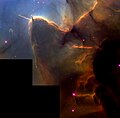ملف:Hs-1999-42-a-full jpg.jpg

حجم هذه المعاينة: 608 × 599 بكسل. الأبعاد الأخرى: 244 × 240 بكسل | 487 × 480 بكسل | 779 × 768 بكسل | 1٬039 × 1٬024 بكسل | 1٬516 × 1٬494 بكسل.
الملف الأصلي (1٬516 × 1٬494 بكسل حجم الملف: 1٫59 ميجابايت، نوع MIME: image/jpeg)
تاريخ الملف
اضغط على زمن/تاريخ لرؤية الملف كما بدا في هذا الزمن.
| زمن/تاريخ | صورة مصغرة | الأبعاد | مستخدم | تعليق | |
|---|---|---|---|---|---|
| حالي | 17:30، 1 مارس 2010 |  | 1٬516 × 1٬494 (1٫59 ميجابايت) | Tryphon | Reverted to version as of 22:21, 8 May 2009: 1,516×1,494 px is the original resolution; anything bigger is just scaled-up. |
| 17:24، 1 مارس 2010 |  | 3٬000 × 2٬957 (3٫91 ميجابايت) | Justass | resolution | |
| 22:21، 8 مايو 2009 |  | 1٬516 × 1٬494 (1٫59 ميجابايت) | Fabian RRRR | {{Information |Description={{en|1=ABOUT THIS IMAGE: This NASA Hubble Space Telescope image of the Trifid Nebula reveals a stellar nursery being torn apart by radiation from a nearby, massive star. The picture also provides a peek at embryonic stars formi |
استخدام الملف
الصفحة التالية تستخدم هذا الملف:
الاستخدام العالمي للملف
الويكيات الأخرى التالية تستخدم هذا الملف:
- الاستخدام في af.wikipedia.org
- الاستخدام في ast.wikipedia.org
- الاستخدام في bg.wikipedia.org
- الاستخدام في ca.wikipedia.org
- الاستخدام في de.wikipedia.org
- الاستخدام في el.wikipedia.org
- الاستخدام في en.wikipedia.org
- الاستخدام في en.wikibooks.org
- الاستخدام في es.wikipedia.org
- الاستخدام في fa.wikipedia.org
- الاستخدام في fr.wikipedia.org
- الاستخدام في hr.wikipedia.org
- الاستخدام في hu.wikipedia.org
- الاستخدام في id.wikipedia.org
- الاستخدام في it.wikipedia.org
- الاستخدام في ja.wikipedia.org
- الاستخدام في ka.wikipedia.org
- الاستخدام في lb.wikipedia.org
- الاستخدام في mk.wikipedia.org
- الاستخدام في ml.wikipedia.org
- الاستخدام في mzn.wikipedia.org
- الاستخدام في pl.wikipedia.org
- الاستخدام في pt.wikipedia.org
- الاستخدام في ru.wikipedia.org
- الاستخدام في sh.wikipedia.org
- الاستخدام في sv.wikipedia.org
- الاستخدام في uk.wikipedia.org
- الاستخدام في vi.wikipedia.org
- الاستخدام في zh.wikipedia.org

